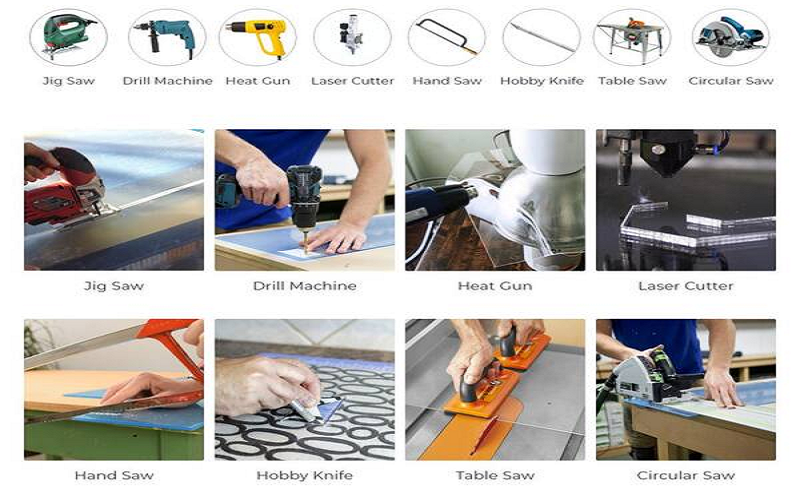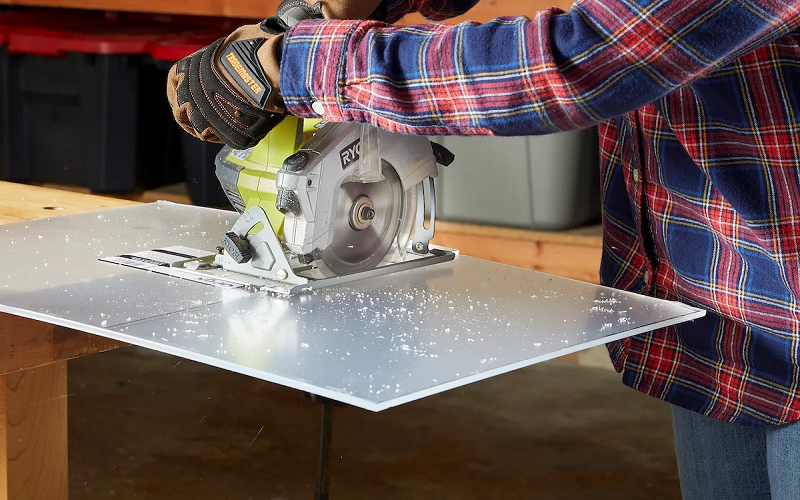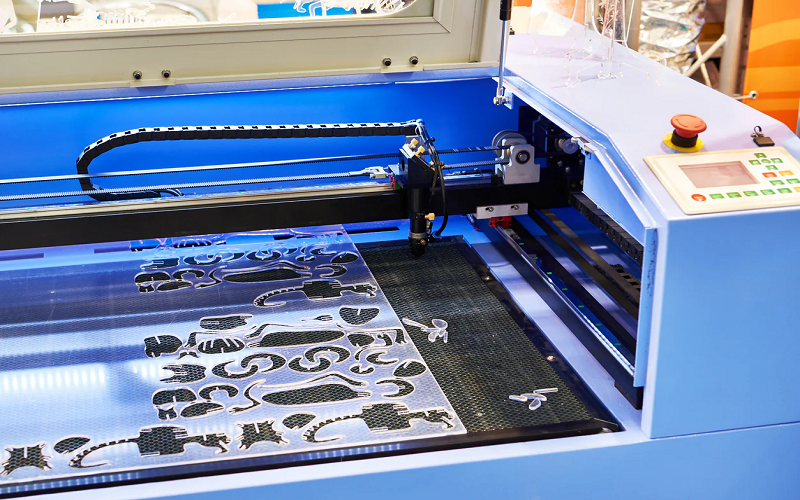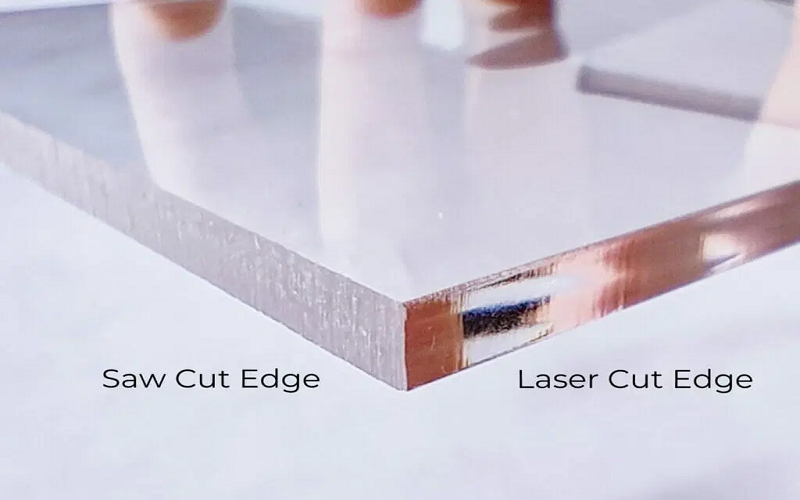Acrylic sheets, with their high transparency, strength, and excellent processability, have become a popular choice across multiple industries, including construction, advertising, transportation, and medicine.
Through precise cutting and processing, acrylic products can be crafted into various shapes and sizes to meet the diverse needs of different fields.
In this article, we will share practical methods for cutting acrylic sheets, providing you with guidance to ensure accuracy and professional results.
Choosing the Right Tools to Cut Acrylic Sheets
The right tool to cut acrylic sheets depends on your specific needs and project requirements. Here’s a breakdown of the most common options:
1.Power Saw
Ideal for cutting larger acrylic sheets, power saws typically feature carbide-tipped blades that deliver fast, accurate cuts.
When using a power saw, selecting the appropriate blade and controlling cutting speed are crucial to prevent excessive heat buildup and burrs on the cut edge.
2.Hand Saw
Perfect for smaller acrylic sheets, a hand saw consists of a blade and frame, operated by manual push-and-pull motion.
To achieve a smooth, even cut, pay attention to the saw teeth selection and cutting angle during operation.
3.Laser Cutting Machine
Suitable for acrylic sheets of all sizes and shapes, laser cutters use a focused beam to slice through the material with exceptional speed and precision, leaving a polished, smooth edge.
Adjusting laser power and cutting speed is key to optimizing cut quality and efficiency.
4.Engraving Machine
Best for intricate or detailed work, engraving machines excel at precisely cutting acrylic sheets, especially for complex patterns.
They produce refined results with clean edges, guided by design patterns.
However, operating an engraving machine requires technical skill and experience due to its complexity.

Selecting the right tool to cut acrylic sheets depends on several key factors:
- Sheet Thickness and Hardness
| Sheet Thickness | Appropriate Tool |
| Thin sheets (1-3 mm) | A utility knife or scoring tool works well |
| Medium-thick sheets (3-10 mm) | Opt for a hand saw, jigsaw, or electric scroll saw |
| Thick sheets (10 mm and above) | A power saw (such as a circular saw) or laser cutting machine is recommended |
- Cutting Precision
For projects requiring high accuracy, laser cutting machines or engraving tools are ideal due to their precision capabilities.
- Cutting Speed
Electric saws and laser cutters are best suited for large-scale production or situations demanding high efficiency.
- Operational Complexity
Hand saws and basic engraving tools are relatively simple to use, while laser cutters and advanced engraving machines require a certain level of technical skill and experience.
How To Cut Acrylic Sheet?
Method 1: Score-and-Snap Technique (Ideal for Thin Sheets)
This method works best for thin acrylic sheets (1-3 mm):
- Use a marker and ruler to draw a cutting line on the acrylic sheet.
- Place the sheet on a flat, hard surface and secure the ruler along the marked line.
- With a utility knife, score the line repeatedly (about 10-15 passes), applying even pressure until a groove reaches 1/3 to 1/2 of the sheet’s thickness.
- Position the sheet on a table edge, aligning the groove downward with the edge.
- Hold the sheet steady with one hand and apply quick, gentle downward pressure with the other to snap it cleanly along the score.
- Smooth the edges with sandpaper to remove any burrs.

Method 2: Sawing (Suitable for Medium-Thick Sheets)
Perfect for medium-thick acrylic sheets (3-10 mm):
- Mark the cutting line with a marker and secure the sheet with clamps to prevent slipping.
- Use a fine-toothed saw (such as a jigsaw or hand saw) to cut along the line slowly and steadily.
- Maintain a consistent speed to avoid overheating, which can melt or crack the material.
- After cutting, sand the edges with sandpaper for a smooth finish.

Method 3: Power Tools or Laser Cutting (Best for Thick Sheets or Complex Shapes)
For thicker sheets (10 mm+) or intricate designs:
- Power Saw (e.g., Circular Saw): Select a fine-toothed blade, set a moderate speed, and cut slowly and evenly along the marked line.
- Laser Cutting Machine: Ideal for high precision or complex patterns, this professional tool delivers smooth edges without additional finishing.

Tips and Precautions Of Acrylic Sheets Cutting
When cutting acrylic sheets, keep the following points in mind:
Safety First: Wear protective goggles and gloves to prevent injury from flying debris or scratches.
Avoid Overheating: Acrylic can melt when overheated, so avoid excessive force or high speeds during cutting; pause to cool if necessary.
Protect the Surface: Apply masking tape to the sheet’s surface before cutting to prevent scratches.
These tips ensure you cut acrylic sheets without cracks or damage.

Finishing Edges After You Cut Acrylic Sheets
After cutting, the edges of the acrylic may feel rough and require sanding with fine-grit sandpaper to remove burrs and scratches.
This process also strengthens the edges, reducing the risk of cracking.
Additionally, mechanical or manual polishing can be applied to smooth the edges, achieving a polished, visually appealing finish.

Conclusion
Mastering the art of cutting acrylic sheets comes down to three essentials: choosing the right tools, following precise steps, and paying attention to detail.
Whether you’re scoring thin sheets, sawing medium thicknesses, or using advanced tools for complex cuts, the proper approach ensures high-quality results with minimal waste. At Otivic, we understand the importance of precision and durability in every project.
Need trusted acrylic sheet manufacturer or custom cutting services? Contact us for expert solutions tailored to your needs—we’re here to help you bring your ideas to life!

